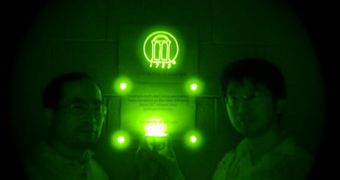A group of investigators from the University of Georgia (UGA) announce the development of an amazing new material, which is capable of emitting light in near-infrared wavelengths for prolonged periods of time. The interesting thing is that it does so after being exposed to sunlight for just a minute.
According to the team behind the material, this innovation could be applied to a wide range of fields, from improving solar energy devices to security applications and new medical diagnostic techniques.
Researchers say that the class to which this material belongs is not uncommon. Similar compounds are used often in things that glow-in-the-dark, in emergency equipment, as well as other applications.
However, what is remarkable about this particular compound is that it can emit near-IR light for a very long time after a very short exposure to light. In addition, this is one of the few materials of this type ever created to emit light in this particular region of the electromagnetic spectrum.
UGA investigators published details of their research in the November 20 online issue of the top scientific journal Nature Materials. The work was led by Franklin College of Arts and Sciences, and Faculty of Engineering associate professor of physics and engineering Zhengwei Pan.
The expert – also the lead author of the work – says that the innovation could be used to create a secret light source for a wide variety of applications, including military and law enforcement. In addition, solar cells based on it may be able to utilize a wider portion of the spectrum in which Sun emits light.
“When you bring the material anywhere outside of a building, one minute of exposure to light can create a 360-hour release of near-infrared light. It can be activated by indoor fluorescent lighting as well, and it has many possible applications,” Pan explains.
He says that an interesting application would be creating it in nanoparticle form, in such a manner that they bind exclusively to cancer cells. Doctors could then use established medical imaging technique to analyze the damaged tissues, and decide on the best possible course of action.
As powder, the material may be mixed in with standard paint, becoming visible only to a select few who have infrared goggles. The stuff is based on a matrix of zinc and gallogermanate, EurekAlert reports.
“Even now, we don't think we've found the best compound. We will continuously tune the parameters so that we may find a much better one,” Pan explains. It took three years for the expert, together with postdoctoral researcher Feng Liu and doctoral student Yi-Ying Lu, to develop the new material.

 14 DAY TRIAL //
14 DAY TRIAL //